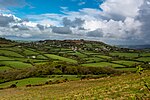Marshwood Vale
Natural regions of DorsetValleys of Dorset

The Marshwood Vale (or Vale of Marshwood) is a low-lying, bowl-shaped valley of Lower Lias clay, in the western tip of the county of Dorset in south-west England. It lies to the north of the A35 trunk road between the towns of Bridport and Lyme Regis, and to the south of the two highest hills in Dorset, Lewesdon Hill (279m) and Pilsdon Pen (277m). It is drained by the River Char, which flows south-west to its mouth on the English Channel coast at Charmouth. All of the vale lies within the Dorset Area of Outstanding Natural Beauty. There is an electoral ward with the same name stretching from Whitchurch Canonicororum north to Thorncombe. The total population of this ward is 1,717.
Excerpt from the Wikipedia article Marshwood Vale (License: CC BY-SA 3.0, Authors, Images).Marshwood Vale
Geographical coordinates (GPS) Address Nearby Places Show on map
Geographical coordinates (GPS)
| Latitude | Longitude |
|---|---|
| N 50.7788 ° | E -2.8306 ° |
Address
DT6 6HW , Marshwood
England, United Kingdom
Open on Google Maps









